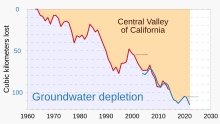
Overdrafting is the process of extracting groundwater beyond the equilibrium yield of an aquifer. Groundwater is one of the largest sources of fresh water and is found underground. The primary cause of groundwater depletion is the excessive pumping of groundwater up from underground aquifers. Insufficient recharge can lead to depletion, reducing the usefulness of the aquifer for humans. Depletion can also have impacts on the environment around the aquifer, such as soil compression and land subsidence, local climatic change, soil chemistry changes, and other deterioration of the local environment.
There are two sets of yields: safe yield and sustainable yield. Safe yield is the amount of groundwater that can be withdrawn over a period of time without exceeding the long-term recharge rate or affecting the aquifer integrity.[2][3] Sustainable yield is the amount of water extraction that can be sustained indefinitely without negative hydrological impacts, taking into account both recharge rate and surface water impacts.[4]
There are two types of aquifers: confined and unconfined. In confined aquifers, there is an overbearing layer called an aquitard, which contains impermeable materials through which groundwater cannot be extracted. In unconfined aquifers, there is no aquitard, and groundwater can be freely extracted from the surface. Extracting groundwater from unconfined aquifers is like borrowing the water: it has to be recharged at a proper rate. Recharge can happen through artificial recharge and natural recharge.[5]
- ^ Liu, Pang-Wei; Famiglietti, James S.; Purdy, Adam J.; Adams, Kyra H.; et al. (19 December 2022). "Groundwater depletion in California's Central Valley accelerates during megadrought". Nature Communications. 13 (7825): 7825. Bibcode:2022NatCo..13.7825L. doi:10.1038/s41467-022-35582-x. PMC 9763392. PMID 36535940. (Archive of chart itself)
- ^ "Safe Yield". Water Education Foundation. 22 June 2020. Retrieved 2022-12-19.
- ^ "Safe yield". solareis.anl.gov. Retrieved 2022-12-19.
- ^ Rudestam, Kirsten; Langridge, Ruth (2014). "Sustainable Yield in Theory and Practice: Bridging Scientific and Mainstream Vernacular". Groundwater. 51 (S1): 90–99. Bibcode:2014GrWat..52S..90R. doi:10.1111/gwat.12160. PMID 24479641. S2CID 34864194 – via Wiley Online Library.
- ^ Lassiter, Allison (July 2015). Sustainable Water Challenges and Solutions from California. University of California. ISBN 9780520285354.